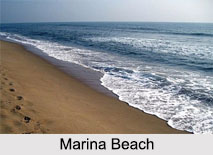 Marina Beach is often considered as the second longest beach in the world. This beach is mainly covered in dust and is situated on the eastern side of Chennai, adjoining the Bay of Bengal. While the Juhu beach in Mumbai is made of short, rocky structures, the Marina Beach is primarily made up of sand. There is a drive along the beach whose environs are decorated with Casuarinas and Palms.
Marina Beach is often considered as the second longest beach in the world. This beach is mainly covered in dust and is situated on the eastern side of Chennai, adjoining the Bay of Bengal. While the Juhu beach in Mumbai is made of short, rocky structures, the Marina Beach is primarily made up of sand. There is a drive along the beach whose environs are decorated with Casuarinas and Palms.
Marina Beach extends from Fort St. George in the north to Beasant Nagar in the south. The beach is famous for its scenic beauty and rich ecosystems. There are statues of noted personalities adorning the beach. The sea on this part is not fit for swimming, as the currents are turbulent.
Location of Marina Beach
Marina Beach is located in the city of Chennai along with the Bay of Bengal. It is 3 kilometres away from Chennai. It is located at Kamarajar Salai Road with a distance of 3 kilometres from Tamil Nadu
History of Marina Beach
There is a proof that, when Fort St. George was built in 1640, the sea lay very close to its walls. Later, with the setting-up of the harbour, that the shore start accumulating sand so distancing itself from the sea. It is supposed that Sir Mountstuart Elphinstone Grant Duff, a British official, was enthusiastic by the peaceful coast during his visit in 1870s. Later, upon his return as Governor General of Madras in 1881, he built a walkway along with the beach with wide-ranging layering, thereby changing the landscape.
The beach was thus given a facelift and an Italian name meaning harbour. The 19th century saw a number of landmarks being built along the walkway, in front of the sea. The country"s first aquarium, built in October 1909, is at present being renovated from its dank interiors to put up a state-of-the-art provision.
Attractions of Marina beach
There are many attractions of Marina beach. Some of the most famous and stunning British buildings like the University of Madras, Senate-House, Chepauk Palace, Presidency College, and Ice House. There are a lot of statues of Tamil scholars and the Victory of Labour and Mahatma Gandhi statue which are believed as impressive pieces of Art.
There is also a 49 meter high old Light House which offers a panoramic vision of the city from its top. The Aquarium in the Marina beach is recognized for its extraordinary and exceptional collections of both tropical sea fishes and fresh water fishes. There is also an Ice House which is located inside the Aquarium and is used to stock up ice. The Velankanni church and the Ashtalakshmi temple are some of the major attractions of Marina beach. The annual Independence Day and the Republic Day traditional parades and air shows are held along the walkway along with the unfurling of the national flag in the Marina. The beach is also the location for some marathon and walkathon campaigns all through the year conducted for a variety of causes.
Incidents on Marina beach
A cyclone of 1966 strokes the region and went under SS Damatis near the Marina whose leftovers are still said to be found underwater. The beachfront was distorted very much when huge waves from the Indian Ocean tsunami hit its shore in December 2004. Massive loss of lives marked a black phase. In November 2012, an oil tanker, stranded due to the cyclone Nilam, ran aground. Several people swarmed the shores to watch the mystifying ship. There was also an oil spill in January 2017 from the accident of two ships near the Ennore Port, north of Chennai, which effected in severe ecological, biological and environmental harm to the coast-line.
Environment of Marina beach
Since the middle of the 20th century, the beach and water have become polluted. Explosion of plastic bags, human waste and other contaminants have rendered many parts of the beach out of order. In recent years, a lot of voluntary organisations have taken up the task of cleaning up the Marina and protecting the ecosystem.
Visiting information of Marina beach
The nearest railway station to marina beach is Chennai Central Train Station which is 3 kilometres away. The better medium to reach Marina beach is, local train from Meenambakkam Airport of Chennai. Bus facilities are also there. From Mofussil koyambedu bus stand of Chennai, Chennai corporation buses are there.



















